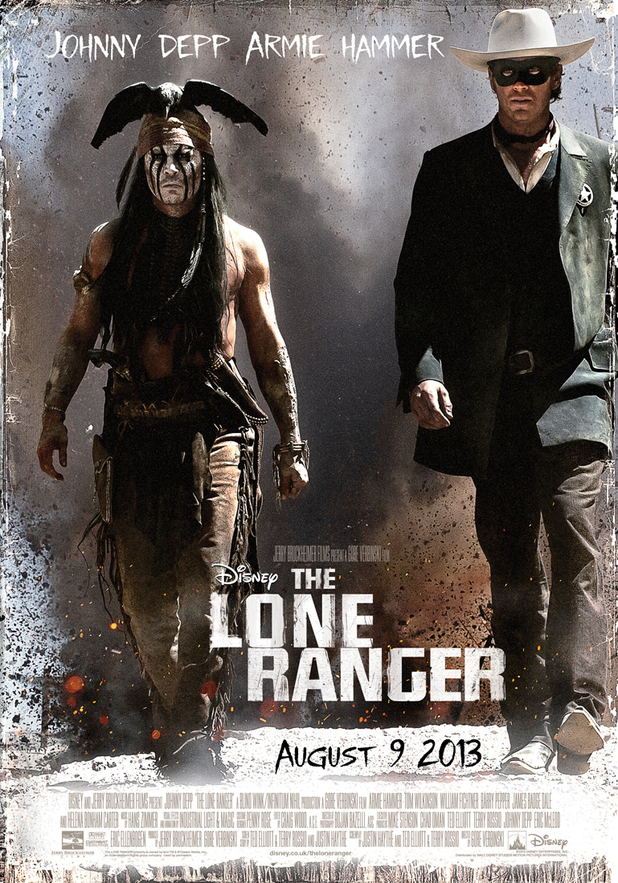
Director: Gore Verbinski
Writers: Ted Elliott, Terry Rossio, Justin Haythe
Starring: Armie Hammer, Johnny Depp, William Fichtner, Tom
Wilkinson, Ruth Wilson, Helena Bonham Carter, Barry Pepper, James Badge Dale
Synopsis: After his brother
is killed, John Reid (Hammer) seeks vengeance. On his journey he finds Tonto
(Depp), similarly on a quest, and the two team up to fight injustice and
conspiracy in the American West.
Forgotten for many years, stuck
in development hell for a decade, The
Lone Ranger seemed destined to stay remembered only as the early incarnations.
Casting and director rumours flew around for what seemed like ages (George
Clooney was, at one point, down as the masked man) until we found ourselves
watching Gore Verbinski tackle the classic adventure with Armie Hammer and
Johnny Depp in the lead roles.
After Rango – a beautifully realised, surrealist Western for children
(that must have been difficult to pitch!) – the prospect of Verbinski handling
the epic American West with live-action and well-known characters seemed
nothing to fret about. If anyone was destined to make The Lone Ranger Verbinski landed that role immediately after Rango. The final outcome is not up to
par with his last film or the first Pirates
of the Caribbean but it’s equally fun, silly and visually stunning.
Apart from Verbinski linking Pirates, Rango, and The Lone Ranger
there is also the million-dollar name Johnny Depp attached to all three. A
lucky charm for Verbinski and many others who have worked with him, Depp is not
the lead here and, surprisingly, never steals the show. Try as he might to
inject some odd humour and strange physicality to scenes, Tonto is quite
clearly the sidekick. Armie Hammer may not have top-billing against someone
like Depp but it’s tough to forget that this is his film. Even as Tonto recalls
the story (the film bookended with the recollection), you are already
accustomed to the Ranger’s iconography with the small child being told the
story costumed up to look like the Lone hero.
John Reid has to become The Lone
Ranger, much like Hammer has to become the lead. He’s not a familiar face to
most audience members and has clearly got to earn that top billing title.
Still, with his part in this that should never become a future issue as Hammer
unquestionably delivers on his lead duties. Sets and set-pieces may be
exuberant and costly-looking but the casting is not something to match the
aesthetic expense. Sure, there are names like Depp and Helena Bonham Carter
attached (though Carter gets perhaps one of the smallest parts) yet looking
elsewhere you will find Tom Wilkinson, Ruth Wilson and William Fichtner. Cast
your minds back (no pun intended) to the
Pirates series and you had people not typically sort out for big
blockbusters. Even Depp at that stage was a curious addition to a Disney film,
a place in Hollywood that now seems nothing but ordinary. It’s Verbinski’s
incentive that sees these huge films Barry Peppered with character actors; it
work wonders to not be momentarily distracted every time a recognisable face
appears.
Casting his worlds is never what
garners the greatest attention Verbinski seems to take, arguably. In his films
he dresses and designs his diegetic landscape with meticulous detail. Some many
shots show the tiniest of details (from dirt under fingernails, the smear of
lipstick, to the fine silverware of an elegant table) that are absolutely stunning.
That level of attention for the mise-en-scène is seldom seen in
contemporary cinema, mostly reminiscent of classic directors such as Douglas
Sirk and Nicholas Ray. On top of set-design and costume, Verbinski has equally
focused on the surrounding environment. The Fordian backdrops of Monument
Valley, Leone-styled train station scenes and postcard pictorials of the old
West are captured beautifully by cinematographer Bojan Bazelli.
The reminder to all those famed
Westerns has not been incorporated accidentally, working towards the film’s
greatest asset – the revitalisation of classic adventures and Westerns. Take the
film seriously and you fail to see the enjoyment of it all. There are moments
where the writers can’t help impart some historical significance and these only
occasionally work. A horrific massacre shown mid-way through of a tribe of
Comanches is shocking and powerful; what does not help is ignorance towards
that destruction when a joke about a horse quickly follows after. This as the
purest example of two tones not blending together, yet Verbinski is mainly set
on thrills and comedy.
It’s never laugh-out-loud funny,
possibly due to the partnership of Hammer and Depp taking an hour to achieve a
noticeable chemistry. Nevertheless, there comes a point in the film where the
William Tell score/Lone Ranger theme erupts, the Lone Ranger and Tonto pounce
into action and excitement pulsates through you. The big set-pieces are often
stunning (with the final fight incredibly well story-boarded and executed),
constantly keeping you entertained.
As much as the early scenes can
be enjoyed with the Lone Ranger and Tonto, its about them so some may struggle
with the first hour. The relationship with the Lone Ranger and Tonto takes its
time to germinate, though it does end with a strong bond between the two. It
deserves its sequel to expand on the pair along with Verbinski’s gorgeous
depiction of the West. Conversely, it deserves to continue on with the
tradition it’s campaigning for – the classic adventure with heroes, sidekicks,
villains, love interests and escapades.
The violence maybe a little too
strong for younger audiences (12A being a tame certificate for some scenes) and
the aforementioned love interest may not mean much, yet this is a kids’ film
that relishes the inanity and action. Much like the boy being told the story in
the film, this will give children a new hero to worship (together with a new
Halloween outfit for the parents to buy) and a genre and figure they may have
only heard about from their grandparents.
****
Also posted on LiveForFilms
No comments:
Post a Comment